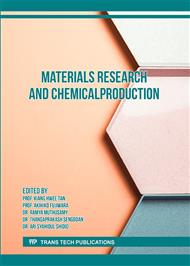p.13
p.29
p.41
p.51
p.65
p.71
p.77
p.83
p.89
Effects of Plasticizers on Physical and Mechanical Properties of Tamarind Kernel Powder Film
Abstract:
A plasticizer is one of the essential substances for biopolymer film fabrication. Generally, plasticizers enhance the elasticity of the film by interrupting the hydrogen bonds of the polymer chains. Different types and amounts of plasticizers play important roles in the mechanical properties of the biopolymer film. Glycerol and sorbitol are the most popular plasticizers for biopolymer film production because of their safety for use as food additives (approved by U.S. Food and Drug Administration, FDA) and cost-effectiveness. The objective of this research is to study the influence of glycerol and sorbitol on the properties of the biopolymer film fabricated from tamarind kernel powder (TKP). The plasticizer content was controlled at 5% w/w. The weight ratio between glycerol and sorbitol was varied as 5:0, 4:1, 3:2, 2.5:2.5, 2:3, 1:4, and 0:5, respectively. The physical characteristics of the films were analyzed. The results demonstrated that glycerol and sorbitol improved the mechanical properties of the biopolymer film differently. The TKP film supplemented with glycerol and sorbitol could be a potential candidate for food packaging.
Info:
Periodical:
Pages:
65-69
Citation:
Online since:
September 2023
Keywords:
Price:
Сopyright:
© 2023 Trans Tech Publications Ltd. All Rights Reserved
Share:
Citation:



